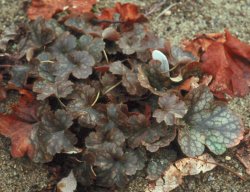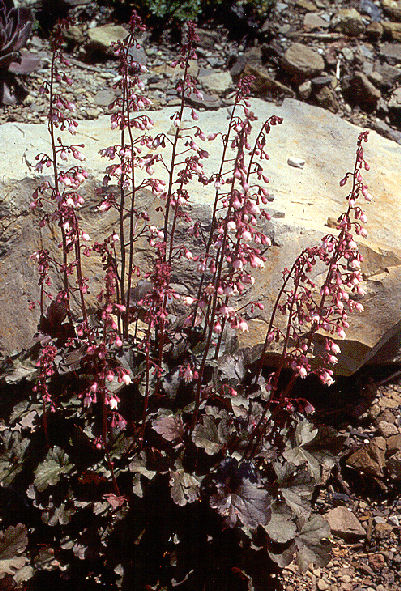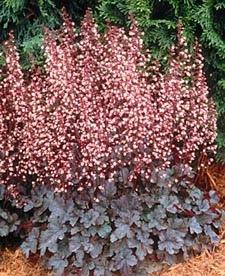|
Home
Caroline
Crystal
Spires
Dark
Chocolate
Frosted
Violet
Harmonic
Convergence
Hearts
on Fire
Jade
Gloss
Midnight
Burgundy
Moonlight
Petites
Purple
Mt Majesty Raspberry Chiffon
Raspberry
Ice
Rose
Majesty
Rose
Mirrors
Royal
Velvet
Shenandoah
Mountain
Silver
Light
Silver
Lode
Silver
Scrolls
Stainless
Steel Steel City
|
Origin
of Garden Heuchera
The
coralbells are a group of American plants that are found wild mostly on
slopes and cliffs from Connecticut to western Canada and south into
Mexico. In general they grow as tufts of foliage, from which spikes of
small flowers rise in spring to summer. They vary from forms only a few
inches high ( eg. H. nivalis of
the Rocky Mountain alpine zone) to forms over three feet tall (H.
maxima of California).
 |
Few
of the larger wild species are considered garden plants, since the
flowers of almost all are green or whitish and inconspicuous. Some
small western species are attractive enough to be grown in the rock
garden. H. hallii, H. pulchella (left) ,
H. hirsutissima, H. grossularifolia, H. merriamii, and
smaller forms of H. cylindrica are pretty plants
well suited to rock garden conditions. (For more on rock gardening go
to the North
American Rock Garden Society
site.) One southwestern species, H. sanguinea, has
excellent pink flowers and was hybridized with other larger, hardier
species to produce the garden coralbells (eg. Bressingham hybrids) that
dominated the market until the 1990s. H. sanguinea
and all of the pink and red flowered coralbells are avidly visited by
hummingbirds and are good nectar sources. |
 |
In
the eastern species there are forms with handsomely colored foliage
that have been recognized as good garden perennials in the last 20
years. There are two basic types of foliage coloration. The first is a
general bronze-purple tint, similar to that found in the new growth of
many plants, but lasting through the year. This important trait in
heuchera probably came from H. villosa f.
purpurea (left), a bronze-leaved wild form from the Upper
South. Bronze-purple forms have been selected in many other garden
plants from 'Crimson King' maple to the sweet potato 'Blackie.' The
purple pigment in young foliage protects rapidly growing cells from
ultraviolet light damage; in purple-leaved forms the genetic means for
breaking down the purple pigments as the foliage matures apparently
does not work. A second foliage coloration is that of green leaves with
white or silver patches between the veins. This coloration is due to
air space between the layers of leaf tissue and is found in plants
other than heuchera (eg. Asarum and Cyclamen).
This structure may increase the amount of light taken in by
pigment cells in the leaf. Several of the larger eastern heuchera such
as H. americana, H. pubescens, and H.
longiflora, often show this coloration in wild plants. The
trait has come into the newer hybrid cultivars from H.
americana and H. pubescens (below).
Other traits that have been bred into some of the new hybrids of the
last decade are miniature size (from the Rocky Mountain alpine species)
and larger flowers (from H. cylindrica and H.
pubescens). |
| An
explosion in new heuchera forms in the 1990s was touched off by the
appearance of hybrids between Heuchera 'Palace
Purple,' a cultivar with evenly bronze leaves, and H.
americana 'Dale's Selection,' a cultivar with silver-mottled
green leaves, among seedlings at Montrose Nursery, run by Nancy Goodwin
in North Carolina. The best of these hybrids combined purple leaf
background with silvery markings for a strikingly beautiful effect. As
soon as the hybrids, distributed under the name 'Montrose Ruby,'
appeared on the market, they were used as the base for many new hybrid
combinations. Dan Heims, in Oregon, used 'Montrose Ruby' and a ruffled
form of H. micrantha, as well as other garden
cultivars, to yield many new hybrid selections, which were
propagated by tissue culture and rapidly brought onto the horticultural
market. Charles Oliver, in Pennsylvania, combined 'Montrose Ruby' with H.
pubescens
and the Rocky Mountain alpine species as well as with some of the older
garden hybrids; he has been slower to introduce new cultivars. More
recently, a number of leaf color mutations have been selected and most
present-day breeding work consists of recombining these forms and the
older cultivars. |
 |
Cultivation
of Heuchera
Heuchera
want well-drained, neutral soil. Generally, they will do best in light
shade during at least the hottest part of the day. In full sun the
foliage may discolor or die back during very hot spells in the summer.
Wild alpine heuchera and miniature forms like the Petites grow well in
gritty scree soil in rock gardens and remain small and graceful,
combining well with other alpines. The Petites do well in rich garden
soil, too, and they will be quite different looking – taller and much
lusher and suitable for front of the border use. Heuchera 'Petite Pearl
Fairy' on the left is growing in a lean scree soil; that on the right
is growing in rich soil suitable for heavy-feeding perennials and
bedding plants.
The
most magnificent heuchera we have seen were growing in trial
gardens in Michigan and the Netherlands in very sandy neutral soil and
in Lancaster Co., PA, where the soil was a limy yellow clay.
The soil at The Primrose Path is acid loam with shale and coal, and our
plants do much better with added ground limestone and nitrogenous
fertilizer, either from manure or 5-10-5 chemical.
Heuchera
hybrids grown for flowers are best used in groups so that the effect is
more substantial. The larger foliage types are effective in small
groups or even as single plants, but can also be used well as large
plantings interspersed with deciduous ferns or hostas. Heucheras will
provide a year-round presence when the other plants are no longer
visible. As midsize foliage plants heuchera are so new to garden
designers that their potential has not yet been realized. One of the
great strengths of heuchera is that they are evergreen and that the
foliage remains very attractive through the winter. When hosta have
retreated underground, heucheras are still handsome. A large proportion
of North American gardeners live in climates where it is cold enough in
winter that there is nothing much happening in the garden but snow
cover comes and goes. These gardeners should think about using
heucheras and other plants that are attractive during the winter in
place of many of the summer-only perennials.
Heuchera have few pests and diseases. Plants that are too moist and
shady may get some fungus problems during the summer. Moving them to a
different site should solve this. The worst insect pest of the
heuchera-tiarella group is the Black Vine Weevil, Otiorhynchus
sulcatus. Larvae of this beetle bore in the roots and crowns
of various plants, eventually causing the top of the plant to die.
There is one generation of weevils per year, with the adults active in
western Pennsylvania in June and the larvae causing most of their
damage in the late summer and early fall. Inspecting wilted plants and
killing the larvae is usually the only control needed in the garden.
Introducing beneficial nematodes every couple of years is a good idea
for control of weevils and other soil pests.
|




